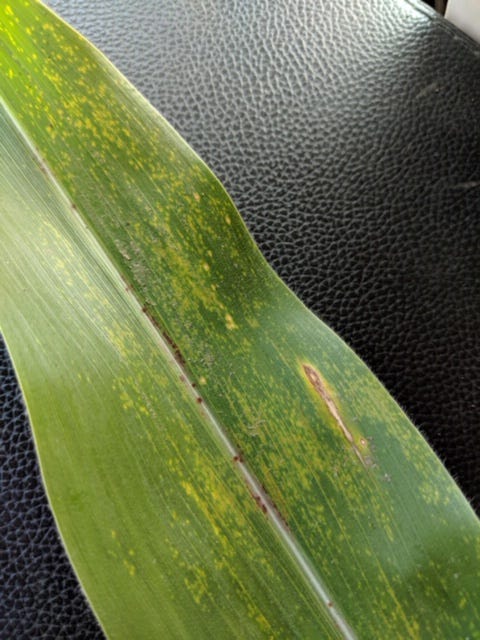
Add physoderma brown spot to the list of corn diseases you should monitor. While it wasn’t considered an economic problem before, the number of fields showing symptoms and the severity of those symptoms have increased in recent years.
“We saw quite a bit of physoderma in 2018 and 2019,” says Betsy Bower, a Ceres Solutions agronomist whose territory includes west-central Indiana. She suspects the disease is on the rise and was particularly noticeable in 2019 because of wetter-than-normal conditions for early corn growth. Few years in history were wetter than 2019. Current long-term forecasts call for a warm, wet spring in 2020.
Information prepared by Jeff Nagel, a Ceres Solutions agronomist based in Lafayette, Ind., indicates the disease prefers conditions where temperatures are warm, 75 degrees F or higher, with frequent rains.
What you should know
According to Iowa State University specialists, physoderma brown spot is caused by the only fungi that produce zoospores. These spores have tails and can swim in free water on plants. They can infect meristematic tissue in corn. Plants are most susceptible 50 to 60 days after planting.
That means infection typically occurs from the V3 to V8 stage, Nagel says. ISU pegs the key infection period as V5 to V9. A V3 plant has three fully exposed leaves, and a V9 plant has nine leaves with leaf collars, including the bottom, rounded leaf.
Symptoms show up as very small, yellowish-to-brown oval spots on leaves, which usually appear in bands across the leaf. Dark purplish-to-black areas develop in leaf midribs, and can show up on leaf sheaths, stalks and ear husks. Leaf symptoms alone could be confused with southern rust or eyespot, but the purplish oval spots set physoderma apart.
According to ISU, these dark purple spots are filled with thousands of sporangia. They overwinter in residue for two to seven years. Once splashed into the whorl of growing corn plants during rain events, they produce the zoospores.

LEAF SYMPTOMS: Note tiny spots and patterns on this leaf. Betsy Bower, Ceres Solutions, says specialists at Purdue University confirmed physoderma infection.

If you see physoderma symptoms, it’s likely too late to help this year’s crop. However, if you saw these symptoms in 2019, you should take heed for 2020. Physoderma can also cause nodal rot, which can lead to significant stalk lodging.
Treatment options
Researchers say some hybrids are more susceptible, Nagel notes. If you confirm that certain hybrids are susceptible, consider applying fungicides in those fields this year if, in fact, the early growing season is warm and wet, he advises.
Knowing that you’ve seen physoderma on that farm in the past might also be a factor favoring treatment. If you’re going to make a fungicide application for physoderma, target corn in the V5 to V8 growth stage, Nagel says.

2 DISEASES: Physoderma symptoms are present on the leaf to the upper left of the ear and on the stalk near the ear. Gray leaf spot lesions appear on the leaf in the lower right.

Possible fungicide choices include Headline AMP at 10 ounces per acre, Delaro at 8 ounces, Stratego YLD at 4 ounces, or Trivapro or Miravis Neo at 13.7 ounces, Nagel says. You can apply them alone or with a product called MasterLock at 6.4 ounces per acre, or tank-mix fungicides with postmergence herbicides if you’re also going after weeds, he adds.
Nagel emphasizes that these are suggestions. Always consult a current product label for complete application instructions and possible updates.
About the Author(s)
You May Also Like




